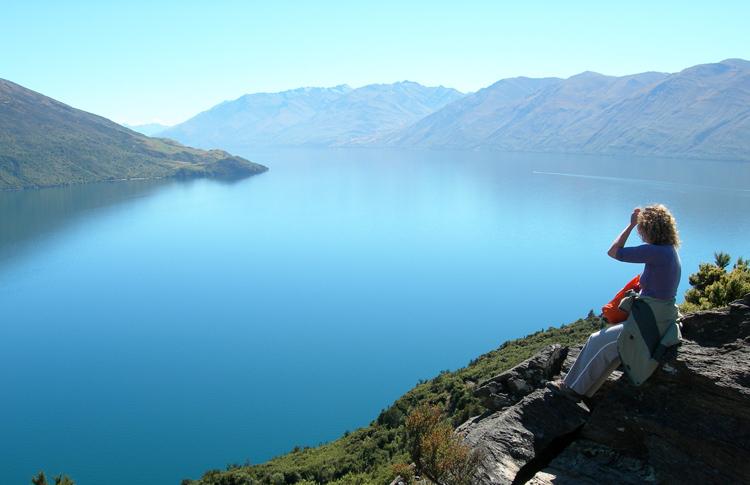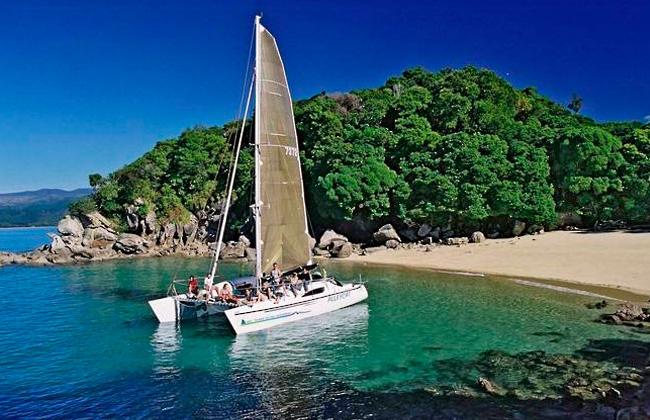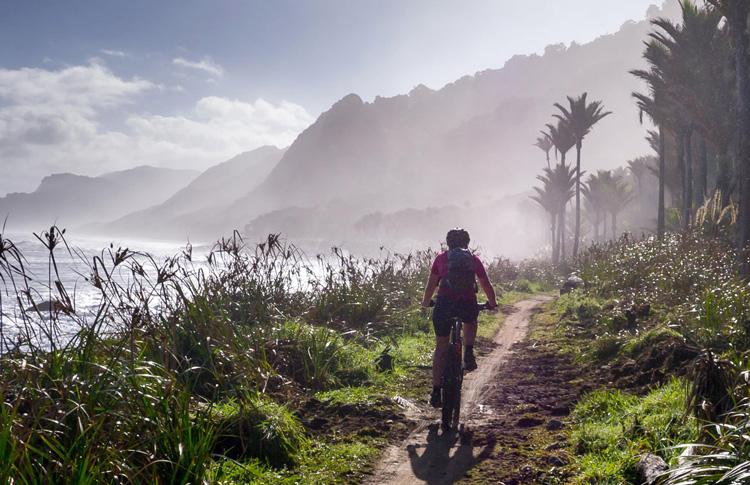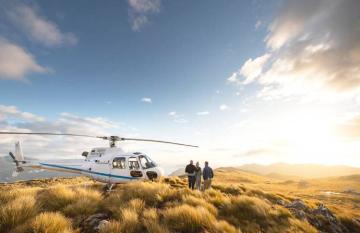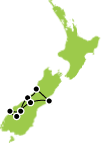
February is a fantastic time to plan a South Island tour itinerary. With hot days, mild evenings, little rainfall and plenty of sunshine, it’s a fabulous time to get out and explore the many beautiful landscapes that the South Island has to offer.
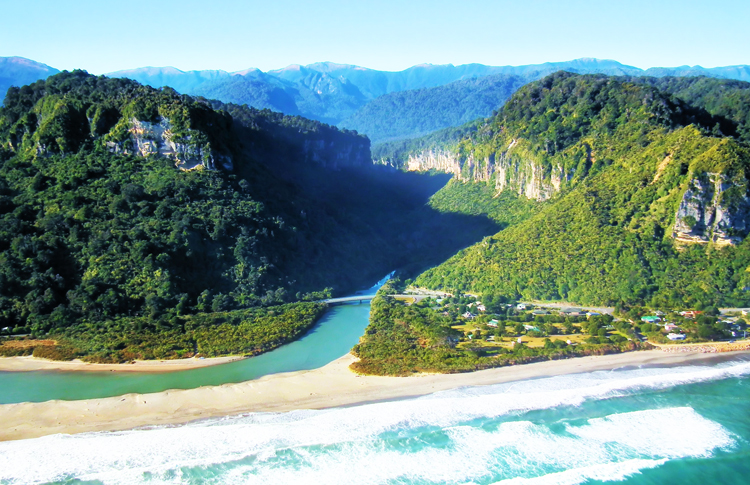
Contents
Expect to see plenty of jandals (a.k.a. “flip-flops”) out this month, because February is peak summer in the South Island – typically meaning warm to hot days, lots of sunshine hours, and relatively low rainfall compared with other times of the year. This makes it a popular time for South Islanders to get out and enjoy the great outdoors, whether that means in the mountains, at the lake, on the beach, or relaxing at one of the South Island’s many small holiday towns.
Average Temperatures in the South Island in February
The South Island’s weather is diverse, and what to expect in February changes from place to place. However, overall you can expect relatively warm to hot temperatures throughout February. Average daytime highs for the entire South Island throughout the month are 22°C (71.5°F), with nightly lows around 11°C (52°F) and an overall average temperature of 15°C (59°F).
If you’re wondering what to expect from particular stops along your South Island trip, though, take a closer look here:
Queenstown: Queenstown and the Central Otago lakes region regularly has warm days throughout February, with daily highs of 22°C dropping to around 9°C at night, averaging 15°C across February.
Christchurch: February can bring some sweltering temperatures in Christchurch. In fact, Christchurch is regularly the hottest place in New Zealand during early February, and four of the five hottest days ever recorded in New Zealand – including 42°C in Christchurch – have been in eastern Canterbury during this period. However, summer days are usually cooled by the prevailing northeasterly breeze, and it’s much more normal to see temperatures in the low to mid-20’s. Average highs are 22.1°C, lows 12.2°C, and an overall average temperature of 17.2°C for February.
Nelson: Nelson and the surrounding Tasman area enjoys sunny days and warm temperatures throughout February, averaging 17.9°C for the month, with daily highs of 22.6°C and nightly lows at a mild 13.3°C.
Dunedin: Things are still mild in Dunedin in February. The average high is 18.6°C, dropping to around 11.5°C at night, with an overall average temperature of 15°C.
Average Sunshine Hours Per day in the South Island in January
If you want to enjoy some time in the sun and plenty of clear days, February is a great month to plan a South Island holiday:
Nelson: Nelson is the “Sunshine Capital of New Zealand”, and February sees plenty of it – a total of 231 hours on average, meaning 8.25 hours of sunshine per day on average. Gorgeous.
Christchurch: The summer sun starts to fade a bit during February in Christchurch, but there’s still plenty of sunshine to go along with those hot days – 6.97 sunshine hours per day, in fact.
Queenstown: Hidden away in the mountains from the encroaching coastal weather, Queenstown still enjoys peak-summer sunshine hours in February, with 7.4 hours of sunshine per day.
Dunedin: You may see some clouds hovering for periods over Dunedin in February, but overall you can still expect about 5.6 hours of sunshine a day across the month of February.
Average rainfall in the South Island in February
Given its geographic diversity, it can be hard to make sweeping statements about rainfall across the South Island. However, if there’s one month when you can safely generalise about average rainfall in the South Island, it’s February: it’s dry!
How much rain to expect, of course, still depends a lot on where exactly you want to go – for example, February is typically the driest month of the year in Christchurch (40 mm), Nelson (58 mm) Queenstown (60 mm), and the otherwise perennially wet West Coast towns of Hokitika (165 mm) and Westport (130 mm). Milford Sound’s 500 mm average rainfall for the month is actually low by its own, world-leading rainfall standards; while Blenheim and the Marlborough region is one of the driest places in New Zealand in February, barely getting 20 mm of rain on average for the month.
Best Things to do in the South Island in January
With most New Zealanders going back to work and school around the end of January, February can be a great time to explore the South Island without any crowds. Whether you want to be active, take it easy, or pack in the sight-seeing, there are hundreds of fantastic things to do in the South Island in February.
Here are just a few to get you started:
See Aoraki/Mount Cook in all its Glory
February has the highest average temperatures, the lowest snow and rainfall, and (just about) the most sunshine hours of any month of the year at Aoraki-Mount Cook, New Zealand’s highest mountain. Walk to the Glacier Lake, have dinner at the historic Hermitage Hotel, or simply stop at the head of Lake Pukaki and enjoy the million-dollar views.
Hike the Heaphy Track
February is the ideal time to enjoy one of New Zealand’s acclaimed Great Walks. Taking you from the pristine coastal landscapes of Golden Bay through lush native forests to the rugged and roaring seas of the West Coast, the Heaphy is a manageable-for-all-ages track that offers the best of the South Island in a nutshell.
How to Plan Your South Island Getaway
First Light Travel have a number of expert South Island travel advisors at hand, online, who can help you piece together your own customised South Island itinerary. Alternatively, there’s already a number of superb self-drive South Island tour itineraries on the First Light Travel website that you can book now. You can also find any information you need before you go on the New Zealand travel information blog.
Recent Posts
Blog Categories
Blog archives
- April 2025 (2)
- February 2025 (3)
- January 2025 (6)
- December 2024 (12)
- November 2024 (3)
- October 2024 (2)
- July 2024 (2)
- May 2024 (12)
- April 2024 (2)
- March 2024 (2)
- January 2024 (2)
- November 2023 (10)
- October 2023 (4)
- August 2023 (1)
- May 2023 (2)
- April 2023 (2)
- March 2023 (17)
- February 2023 (4)
- January 2023 (4)
- December 2022 (11)
- November 2022 (7)
- October 2022 (1)
- May 2022 (1)
- March 2022 (3)
- February 2022 (3)
- January 2022 (1)
- December 2021 (1)
- August 2021 (1)
- June 2021 (1)
- May 2021 (2)
- February 2021 (1)
- August 2020 (1)
- July 2020 (1)
- May 2020 (1)
- April 2020 (1)
- March 2020 (1)
- January 2020 (1)
- December 2019 (1)
- November 2019 (1)
- October 2019 (1)
- September 2019 (1)
- August 2019 (5)
- July 2019 (2)
- June 2019 (1)
- May 2019 (3)
- April 2019 (1)
- March 2019 (1)
- February 2019 (1)
- January 2019 (1)
- December 2018 (1)
- November 2018 (1)
- September 2018 (1)
- August 2018 (1)
- July 2018 (1)
- June 2018 (1)
- May 2018 (1)
- April 2018 (1)
- March 2018 (1)
- February 2018 (1)
- January 2018 (1)
- December 2017 (1)
- October 2017 (1)
- September 2017 (1)
- August 2017 (1)
- July 2017 (1)
- June 2017 (1)
- May 2017 (1)
- April 2017 (1)
- March 2017 (1)
- February 2017 (1)
- January 2017 (1)
- December 2016 (1)
- November 2016 (1)
- October 2016 (1)
- September 2016 (1)
- August 2016 (1)
- July 2016 (1)
- June 2016 (1)
- May 2016 (1)
- April 2016 (1)
- March 2016 (1)
- February 2016 (1)
- January 2016 (1)
- December 2015 (1)
- November 2015 (1)
- October 2015 (1)
- September 2015 (1)
- August 2015 (1)
- July 2015 (1)
- June 2015 (1)
- May 2015 (1)
- April 2015 (1)
- March 2015 (1)
- February 2015 (1)
- January 2015 (1)
- December 2014 (1)
- November 2014 (1)
- October 2014 (1)
- September 2014 (1)
- July 2014 (1)
- June 2014 (3)
- May 2014 (1)
- April 2014 (1)
- March 2014 (1)
- February 2014 (1)
- January 2014 (1)
- November 2013 (15)
- October 2013 (1)
- September 2013 (1)
- August 2013 (1)
- July 2013 (1)
- May 2013 (1)
- April 2013 (1)
- March 2013 (1)
- February 2013 (1)
- January 2013 (1)
- December 2012 (1)
- November 2012 (2)
- October 2012 (2)
- September 2012 (2)
- August 2012 (2)
- July 2012 (2)
- June 2012 (2)
- May 2012 (2)
- April 2012 (3)
- March 2012 (2)
- February 2012 (2)
- January 2012 (2)
- December 2011 (2)
- November 2011 (1)
- October 2011 (2)
- September 2011 (1)
- August 2011 (1)
- July 2011 (1)
- June 2011 (1)
- May 2011 (1)
- April 2011 (1)
- March 2011 (1)
- February 2011 (1)
- January 2011 (1)
- December 2010 (1)
- November 2010 (1)
- October 2010 (1)
- September 2010 (1)
- August 2010 (1)
- July 2010 (1)
- June 2010 (1)
- May 2010 (1)
- March 2010 (1)
- February 2010 (1)
- January 2010 (1)
- December 2009 (1)
- November 2009 (1)
- October 2009 (1)
- September 2009 (1)
- August 2009 (1)
- July 2009 (1)
- June 2009 (1)
- May 2009 (1)
- April 2009 (1)
- March 2009 (1)
- February 2009 (1)
- January 2009 (1)
- December 2008 (1)
- May 2005 (1)


